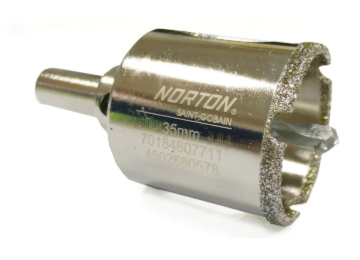Norton
NORTON T490 Lion Silicon Carbide Waterproof Sandpaper Sheets - 78072702453
78072702453
Silicon Carbide Waterproof Sandpaper Sheets
₱21.00
PRO CERAM VB DRY - 70184607712
70184607712
PRO CERAM VB DRY Electroplated diamond drills designed for drilling all types of tiles found in the industry, will also give outstanding performance on hard and brittle materials such as marble, granite and porcelain. Connection: 10mm shank for 3 Jaw Chuck Power Drills Applications: For dry or wet drilling
₱1,100.00 ₱1,375.00
PRO CERAM VB DRY - 70184607711
70184607711
PRO CERAM VB DRY Electroplated diamond drills designed for drilling all types of tiles found in the industry, will also give outstanding performance on hard and brittle materials such as marble, granite and porcelain. Connection: 10mm shank for 3 Jaw Chuck Power Drills Applications: For dry or wet drilling
₱1,320.00 ₱1,650.00
PRO CERAM VB DRY - 70184607710
70184607710
PRO CERAM VB DRY Electroplated diamond drills designed for drilling all types of tiles found in the industry, will also give outstanding performance on hard and brittle materials such as marble, granite and porcelain. Connection: 10mm shank for 3 Jaw Chuck Power Drills Applications: For dry or wet drilling
₱1,680.00 ₱2,100.00
Min: ₱1.00 Max: ₱22,500.00
₱1 ₱22500
Recently viewed products
-
NILFISK VACUUM BLUE WET/DRY 37L 60HZ-NFATTIX400MPC22
-
Stanley Demolition Hammer
-
Dewalt Vacuum, DWV900L-QS
-
RATCHET TIE DOWN JJ HOOK 5MX38MM 1000KG-ME376041
-
S-Ks Tools USA JM-10015SH 15 Tons Hydraulic Bottle Jack (Green)
-
CHUBB SAFE OPAL SAFE ELECTRIC LOCK 34.4X42.4X38.8CM WHITE - CSOSELW25000
-
Delta Kitchen Faucet P/O Sign - DT470BL

















